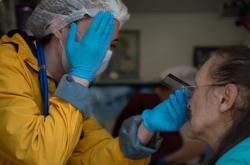Humanity has created countless genres of fiction, yet there is one that I believe occupies a special place in the hearts of many ITMO students: science fiction. Emerging from the Scientific Revolution and the Age of Enlightenment, the genre endured for more than 400 years to modern day, when it made a seamless transition onto the big screen. Sci-fi and film seem to be a match made in heaven: with its special effects, the medium is perfect to capture the unique visuals inherent to most sci-fi stories, while the narrative often reflects on the most pressing issues of the day (Denis Villeneuve’s Dune is a shining example of both of these aspects). Coincidentally, the power of sci-fi cinematography is so great that it can even touch people’s hearts and minds, sparking in them a passion for exploration. When I first saw Star Wars in 2006, my only driving force for the next month was to learn how to create a lightsaber in real life. Fast-forward 17 years and, while I haven’t built any lightsabers, I’m now a proud holder of an engineering degree. I’m sure that hundreds of ITMO students and employees can share a similar story.
Regretfully, modern science doesn't seem to be any closer to fulfilling my dreams of becoming a Jedi. Instead, researchers make breakthrough after breakthrough in the mysterious field of quantum physics. Hollywood follows suit, with the use of quantum mechanics as a narrative device even turning into a common trope. But are science fiction films true to life? To find the answer, we teamed up with Sutanu Chatterjee from ITMO’s School of Physics and Engineering.
Mr. Chatterjee is a research engineer at the school. His team is actively conducting research in the field of wireless power transfer and has recently developed Russia’s first wireless charger for electric vehicles in collaboration with the charging station manufacturer Yablochkov. Their system, which is the first of its kind in Russia, is capable of wirelessly transferring 11kW of power with 95% efficiency.
It is a pleasure to be talking to you! Are you a fan of science fiction movies?
Yes, absolutely! My all-time favorites include: 2001: A Space Odyssey (1968), The Time Machine (2002), Interstellar (2014), and Dune (2021).
First up, let’s start by reviewing a superhero action flick. Here is a clip from Marvel’s Ant-Man:
This clip depicts a concept known as the Quantum Realm. Is that a real thing?
Quantum Realm is not a new kind of realm or place, but it is a point of view. Let me try to explain this concept in simple words: when things get really really small, like atomic and subatomic particles, the laws of classical physics (Newtonian mechanics, etc.) fail to give us satisfactory results. You see, as long as something is big enough and is moving at a speed below the speed of light, classical physics works like a charm, but when things get way smaller and exist at the atomic scale, these classical laws of physics are no longer applicable.
This is exactly why we have quantum physics, which is the study of matter and energy at the most fundamental level – and the Quantum Realm is basically the view of our universe at the most fundamental subatomic scale. It is important to mention that the Quantum Realm is not a new place, but only a way in which we view our universe at the most fundamental subatomic level. To put it in the simplest terms, the Quantum Realm is a perspective on our universe that isn’t governed by the classical laws of physics.
Did Marvel do a good job of representing how things function at the subatomic level?
Before we go subatomic, let’s consider the size and visibility of atoms. Atoms are literally smaller than the wavelength of visible light, which means that it is impossible to see them. After all, we can only see things using light that are bigger than the wavelength of light. However, there are devices such as quantum microscopes that are able to “view” the Quantum Realm!
While we are on the topic of Ant-Man, let me draw your attention to a hilarious and educational short by the California Institute of Technology, featuring some familiar faces:
Apparently, Caltech did actually make quantum chess in real life. What do you think of it?
It’s actually pretty epic! I have played it many times with some like-minded folks around the globe. This game helps you quickly understand the principles of quantum mechanics such as superposition and entanglement and also requires knowledge of the measurement problem. I feel that this game is a great way to start understanding how quantum mechanics works. I thoroughly recommend playing this if you’re interested in getting acquainted with the mysterious field of quantum physics!
Now, it’s time to move away from the works of Paul Rudd (sorry, Paul) and onto a less light-hearted motion picture: Transcendence.
True to genre conventions, this 2014 thriller explores AI-human relations and ponders the meaning of life, but there is a particular piece of technology in these two clips that I would like to draw your attention to – quantum computers. So, how do quantum computers differ from traditional ones?
Traditional computers are designed to follow a specific set of instructions/rules that makes them very reliable. But on the other hand, it also makes them terrible at solving certain kinds of problems – for example, imagine trying to solve a supermassive maze with millions of paths and only one correct route out.
In the case of a traditional computer solving this problem, it will solve it by assessing every single path and finding the correct path that leads us out of the maze. This is time-consuming and is based on trial and error.
What if, instead of solving this problem through trial and error, we could consider all possible routes simultaneously? This is exactly how quantum computers work!
Quantum computers do this with “qubits.” Qubits (basic units of information, like bits in traditional computers – Ed.) operate according to the laws of quantum mechanics: the theory that physics works differently at the atomic and subatomic scale. It uses superposition and entanglement to perform very efficient calculations. For the maze example that we talked about earlier, the superposition state would contain all the possible routes. And then we’d have to collapse the state of superposition to reveal the likeliest route out of the maze.
How realistic is the one shown in Transcendence?
The one shown in the movie looks more like an HPC (high-performance computing) cluster computing network. It basically looks like the supercomputers that are presently in use today. HPC uses supercomputers and computer clusters to solve advanced computational problems. By the way, we have them here at ITMO. It is hard to say if it is realistic or not, since we don’t know what a commercial quantum computer would look like in the near future, but for now, here’s what a quantum computer looks like today:

Credit: IBM / flickr.com / CC BY-ND 2.0
To conclude our review, let’s unwind with some scenes from a classic sitcom:
The Big Bang Theory used Erwin Schrödinger’s famous thought experiment as a punchline multiple times. However, is Sheldon’s interpretation correct? The cat can’t really be both dead and alive, can it?
Actually, Schrodinger's cat is not both dead and alive, any more than an electron simultaneously exists at every point in space. The key point is that a system cannot be in multiple states at once.
Schrodinger's cat is always in a single state. There is an equal probability of us “measuring” the cat to be either alive or dead once we open the box. Therefore, the cat is in a state that is a superposition of our “life states”: alive and dead.
This state tells us that there is a probability of 0.5 of observing the cat as alive and a probability of 0.5 of observing the cat as dead.
Once we open the box (perform a "life state" measurement of the system), the state of the cat collapses to one of the life states (eigenstates of the "life measurement operator"). So we observe the cat as either alive or dead. It is important to understand that before we open the box, the cat is not both alive and dead. The system cannot be in multiple states at once. It is in a single state, and this state is described as a superposition of life states. Once we open the box, the cat is in a new single state, which is one of the two life states. We cannot determine which state the cat ends up in, though, only the probabilities it will end up in a certain state.
So the original experiment was meant to illustrate that we can consider objects of all sizes as being in a superposition?
As long as the box remains closed, the cat is both dead and alive, as we have no idea about its actual state. Quantum mechanics says that the cat is in a superposition of states, alive and dead. Quantum mechanics doesn't impose any maximum size on objects that can be in a superposition of states. It has been observed with large molecules, and there are serious proposals to observe it on a virus.
Thank you for your time, Mr. Chatterjee! One last question: does it annoy you when scientific concepts are misused by pop culture?
I try not to get annoyed, since I do not expect pop culture to be scientifically accurate. Sometimes, it feels good to know that people are at least aware of certain concepts of physics, even though they may not represent them accurately.
Special thanks to Subhrajit Barua




